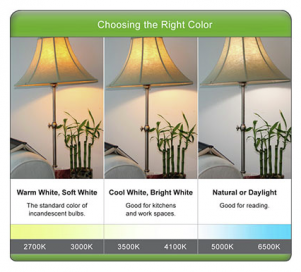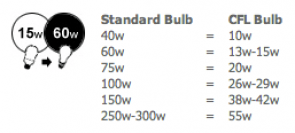WBC Lighting Guide
THE FACTS ARE IN:
According to ENERGY STAR, a joint program of the U.S. Environmental Protection Agency and the U.S. Department of Energy, the average compact fluorescent bulb (CFL) will save about $30 over its lifetime and pay for itself within about 6 months. How? CFL bulbs use about 75% less energy than regular incandescent bulbs and last about 10 times longer. They also produce 70% less heat than standard incandescent bulbs, which leads to added savings on cooling costs.
STILL HAVE QUESTIONS OR DOUBTS? Hopefully the following information will help. Below are some Frequently Asked Questions about CFLs.
According to ENERGY STAR, a joint program of the U.S. Environmental Protection Agency and the U.S. Department of Energy, the average compact fluorescent bulb (CFL) will save about $30 over its lifetime and pay for itself within about 6 months. How? CFL bulbs use about 75% less energy than regular incandescent bulbs and last about 10 times longer. They also produce 70% less heat than standard incandescent bulbs, which leads to added savings on cooling costs.
STILL HAVE QUESTIONS OR DOUBTS? Hopefully the following information will help. Below are some Frequently Asked Questions about CFLs.
Do CFLs emit a cold, bluish light reminiscent of office lighting?
--Old CFLs were limited in hue-generally 4,500+ Kelvin, a standard metric used to rate the color of light. Today, however, CFLs are available in a range of hues, including the same warm, white light (2,700-3,000 Kelvin) as traditional incandescent bulbs. The higher the Kelvin rating, the bluer the color of the light; the lower the Kelvin rating, the more yellow the color of the light. For example, bulbs with a 2,700 to 3,000 Kelvin (K) number have a warmer, yellower color; 3,500 K to 6,500 K bulbs emit a bluer or whiter light. It is important to note that Kelvin ratings refer only to the color of the light emitted, not the brightness.
--Old CFLs were limited in hue-generally 4,500+ Kelvin, a standard metric used to rate the color of light. Today, however, CFLs are available in a range of hues, including the same warm, white light (2,700-3,000 Kelvin) as traditional incandescent bulbs. The higher the Kelvin rating, the bluer the color of the light; the lower the Kelvin rating, the more yellow the color of the light. For example, bulbs with a 2,700 to 3,000 Kelvin (K) number have a warmer, yellower color; 3,500 K to 6,500 K bulbs emit a bluer or whiter light. It is important to note that Kelvin ratings refer only to the color of the light emitted, not the brightness.
I heard that CFL bulbs don't last very long...?
-- The life of a compact fluorescent bulb varies greatly depending on the quality and price of the product. ENERGY STAR qualified CFLs are rated to last 5 to 10 years, and manufacturers are required to offer at least a two-year limited warranty covering manufacturer defects. Because of this, it's a good idea to save your receipts to document the date of purchase.
In general, compact fuorescent light bulbs work best if they are left on for over 15 minutes each time they are turned on. Frequently switching them on and off will shorten the life of the bulb. Just to put "lifetime" in perspective, the average CFL bulb is rated to last 10,000 hours while a comparable incandescent bulb is rated at 750-1,000 hours. TIPS FOR LONG LIFE BULBS
Do CFLs produce an unpleasant odor and smoke when they fail? --The vast majority of CFLs reach the end their usable life passively. However, sometimes an electrical component can fail in manner that results in some smoke, odor or discoloration of the plastic housing. If this happens, disconnect power to the light fixture, allow the bulb to cool and remove it from its socket by handling the base, not the glass. As technologies improve, this issues is becoming more and more rare.
Do CFLs contain mercury?
--CFLs contain a vey small amount of mercury (roughly equivalent to the tip of a ball-point pen) sealed within the glass tubing. The amount of mercury in a CFL bulb is about 100x less than that in an old thermometer and 600x less than manual thermostats. The mercury in a CFL poses so danger to you as long as it’s sealed in that tube. CLFs should never be thrown in the garbage, instead they should be recycled properly so that the mercury can be recovered and reused. Broken bulbs should be handled with caution., and protocols for clean up exist. EPA CLF CLEAN UP PROTOCOL
Can I use CFLs with a dimmer switch?
--Yes. You should be CFL made specifically for dimmer switches to ensure the most longevity in your bulb. LEARN MORE
Do they flicker?
--The first compact fluorescent bulbs—circa 1985—flickered when they turned, however refined technology has all but eliminated this flicker in today’s bulb. So the short answer is No!
Do CFL bulbs emit UV lighting?
--Most light sources emit a small amount of ultra violet light (UV), however the UV produced by a CFL is far less than the amount produced by natural daylight. LEARN MORE
-- The life of a compact fluorescent bulb varies greatly depending on the quality and price of the product. ENERGY STAR qualified CFLs are rated to last 5 to 10 years, and manufacturers are required to offer at least a two-year limited warranty covering manufacturer defects. Because of this, it's a good idea to save your receipts to document the date of purchase.
In general, compact fuorescent light bulbs work best if they are left on for over 15 minutes each time they are turned on. Frequently switching them on and off will shorten the life of the bulb. Just to put "lifetime" in perspective, the average CFL bulb is rated to last 10,000 hours while a comparable incandescent bulb is rated at 750-1,000 hours. TIPS FOR LONG LIFE BULBS
Do CFLs produce an unpleasant odor and smoke when they fail? --The vast majority of CFLs reach the end their usable life passively. However, sometimes an electrical component can fail in manner that results in some smoke, odor or discoloration of the plastic housing. If this happens, disconnect power to the light fixture, allow the bulb to cool and remove it from its socket by handling the base, not the glass. As technologies improve, this issues is becoming more and more rare.
Do CFLs contain mercury?
--CFLs contain a vey small amount of mercury (roughly equivalent to the tip of a ball-point pen) sealed within the glass tubing. The amount of mercury in a CFL bulb is about 100x less than that in an old thermometer and 600x less than manual thermostats. The mercury in a CFL poses so danger to you as long as it’s sealed in that tube. CLFs should never be thrown in the garbage, instead they should be recycled properly so that the mercury can be recovered and reused. Broken bulbs should be handled with caution., and protocols for clean up exist. EPA CLF CLEAN UP PROTOCOL
Can I use CFLs with a dimmer switch?
--Yes. You should be CFL made specifically for dimmer switches to ensure the most longevity in your bulb. LEARN MORE
Do they flicker?
--The first compact fluorescent bulbs—circa 1985—flickered when they turned, however refined technology has all but eliminated this flicker in today’s bulb. So the short answer is No!
Do CFL bulbs emit UV lighting?
--Most light sources emit a small amount of ultra violet light (UV), however the UV produced by a CFL is far less than the amount produced by natural daylight. LEARN MORE
What fluorescent bulb should replace my old incandescent?
It's easy to see that CFLs use less energy than standard bulbs when you compare the wattage required to produce similar light outputs. A standard 60 watt bulb can be replaced by a 15 watt CFL, which uses 4 times less energy. Use the chart below to compare standard bulb to CFLs. LEARN MORE
It's easy to see that CFLs use less energy than standard bulbs when you compare the wattage required to produce similar light outputs. A standard 60 watt bulb can be replaced by a 15 watt CFL, which uses 4 times less energy. Use the chart below to compare standard bulb to CFLs. LEARN MORE
Aren't LEDs even more efficient than CFLs?
Yes they are and many predict that soon we will be replacing our CFLs with LEDS. They use far less energy than CFLs- 7.5 watts compared to 15 watts and last quite a bit longer- 30,000 hours compared to 10,000. However, general-use LEDs are just coming onto the market.
LEDS are unique in that they are directional, meaning they light what they are pointed at instead of diffusing light in all directions like an incandescent bulb or CFL. They are used widely in electronics and items such as headlamps, stop lights and stage lighting--anything inherently directional nature. Philips has recently released a commercial LED similar to a CFL or incandescent bulb. READ MORE
or LEARN MORE
If you have the means to purchase LEDS at this time, it is certainly a worthwhile investment, however at this time, costs may prove to be prohibitive.
Yes they are and many predict that soon we will be replacing our CFLs with LEDS. They use far less energy than CFLs- 7.5 watts compared to 15 watts and last quite a bit longer- 30,000 hours compared to 10,000. However, general-use LEDs are just coming onto the market.
LEDS are unique in that they are directional, meaning they light what they are pointed at instead of diffusing light in all directions like an incandescent bulb or CFL. They are used widely in electronics and items such as headlamps, stop lights and stage lighting--anything inherently directional nature. Philips has recently released a commercial LED similar to a CFL or incandescent bulb. READ MORE
or LEARN MORE
If you have the means to purchase LEDS at this time, it is certainly a worthwhile investment, however at this time, costs may prove to be prohibitive.


